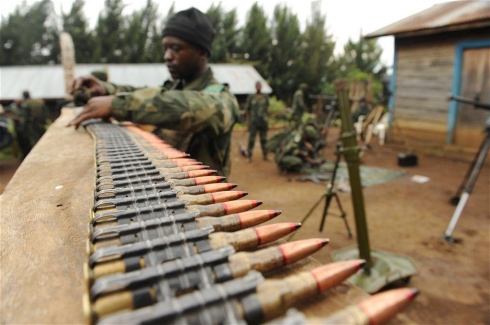WHY DID U.N. ABANDON CONGO OPERATION?

by Christoph Vogel, IRIN
GOMA — This week, a long-awaited military offensive began against a Rwandan rebel group based in eastern Democratic Republic of Congo. It had been planned as a joint operation between Congolese government forces and a unique combat unit of United Nations peacekeepers. But by the time the gunfire began on Tuesday (Feb. 24), the partnership had broken down and the UN had been side-lined.
Three days later, the UN mission in DRC, known as MONUSCO, tweeted: "The #FARDC [DRC army] is carrying out the operation alone after rejecting support from #MONUSCO." How did it come to this?
Politics and human rights
Two UN Security Council resolutions as well as regional political groupings called for the DRC's army (FARDC) and the Force Intervention Brigade (FIB) of the MONUSCO peacekeeping mission to take "decisive military action" against the rebel Democratic Forces for the Liberation of Rwanda (FDLR) if the group failed to surrender and disarm by January 2, 2015. The FIB is the only UN force globally with a mandate to go on the offensive against rebel groups.
A week after that deadline expired with little sign of compliance, Martin Kobler, the head of MONUSCO and the UN secretary-general's special representative in DRC, said he was "very impressed by the high level of preparedness and the team spirit that reigns between the FARDC and the MONUSCO. I am confident about the engagement of the troops in the upcoming operations against the FDLR."
But no operations began.
Then on January 26, DRC President Joseph Kabila announced a reshuffle that saw Gen. Fall Sikabwe take command of the 34th military region, which includes the areas where FDLR is active. Kabila also put Gen. Bruno Mandevu in charge of the operation against the FDLR.
Because these two generals appear on a MONUSCO "red list" on account of human rights abuses allegedly committed by units under their command, the UN reconsidered its role. The nominations "presented a real problem for us," the head of UN peacekeeping, Hervé Ladsous said on February 2.
According to several media reports, the UN called for these nominations to be reversed, something the government flatly rejected.
No details of the two generals' alleged involvement in human rights abuses have been released and several senior FARDC officers told IRIN they were puzzled by Mandevu's inclusion on the red list. Some noted that MONUSCU had worked with Sikabwe before, albeit under a waiver of his red list status.
Neighboring Rwanda, whose government the FDLR would like to oust, accused the UN of politically-motivated procrastination.
The collapse of the DRC-UN partnership became more evident on January 29, when a new plan for the anti-FDLR operation presented by chief of staff Didier Etumba excluded the FIB entirely, with MONUSCO elements providing only logistical support.
Whose side is Kabila on?
There are at least three theories circulating about this breakdown in relations. The first is the FARDC is not really dedicated to neutralizing FDLR; the second is it doesn't want to share credit for an eventual victory. The third is that the breakdown is part of DRC's simmering discontent with the UN mission and the wider international community.
This third theory was lent credence by a long and indignant government communiqué issued on February 16, a day after Kabila upbraided foreign ambassadors for meddling in the sovereign affairs of the DRC.
There is a long history of collusion and alliances between the FARDC and the FDLR notably during the years of civil war between 1998 and 2003. Now, key players in Kinshasa are divided between doves who favor a negotiated settlement, hawks pushing for an all-out military assault, and a third group who view the FDLR as a useful bulwark against regional threats and therefore worth keeping in place.
The FDLR itself, which is said to have no more than 1,500 fighters, is also beset by internal divisions, especially between leader Sylvestre Mudacumura, operational commander Pacifique Ntawuguka and chairman Victor Byiringiro.
So far, the FARDC operation, in the Uvira territory of South Kivu province, appears to have met with little resistance. (Most of the FDLR are based in neighbouring North Kivu). As widely predicted, civilians have left some areas, notably the settlement of Kanyovu, to escape any clashes.
Since the start of the current offensive, MONUSCO has repeatedly tweeted about absence of any abuses such as looting or mistreatment of civilians by FARDC.
And in perhaps another sign of rapprochement, MONUSCO reported on a joint mission by its personnel and government officials to the combat zone to raise awareness about the needs of people displaced by the operation.
———
Christoph Vogel is a researcher at the University of Zurich and independent analyst at www.christophvogel.net.
This story first ran Feb. 26 on IRIN.
Photo: The army in the Democratic Republic of Congo is going it alone after a dispute with the UN. Credit: Guy Oliver/IRIN
From our Daily Report:
UN: world refugees break record
World War 4 Report, Jan. 10, 2015
UN approves Congo 'intervention brigade'
World War 4 Report, March 29, 2013
Pressure on Rwanda over role in Congo war
World War 4 Report, Nov. 21, 2012
Hidden hand of US behind Congo crisis?
World War 4 Report, Nov. 1, 2008
See also:
THE POLITICS OF DENIALISM
The Strange Case of Rwanda
by Gerald Caplan, Pambazuka News
World War 4 Report, August 2010
—————————-
Reprinted by World War 4 Report, March 1, 2015

















Recent Updates
1 day 18 hours ago
2 days 26 min ago
2 days 2 hours ago
2 days 16 hours ago
2 days 16 hours ago
3 days 22 hours ago
4 days 16 hours ago
1 week 21 hours ago
1 week 1 day ago
1 week 1 day ago